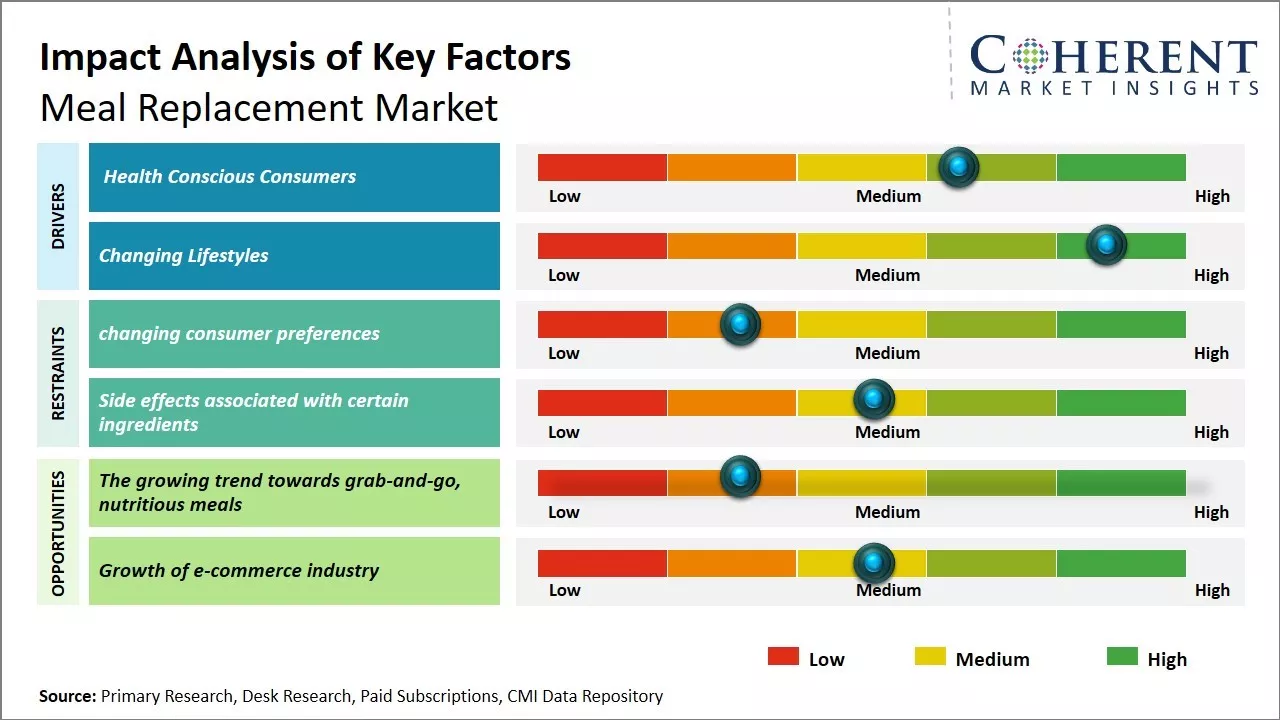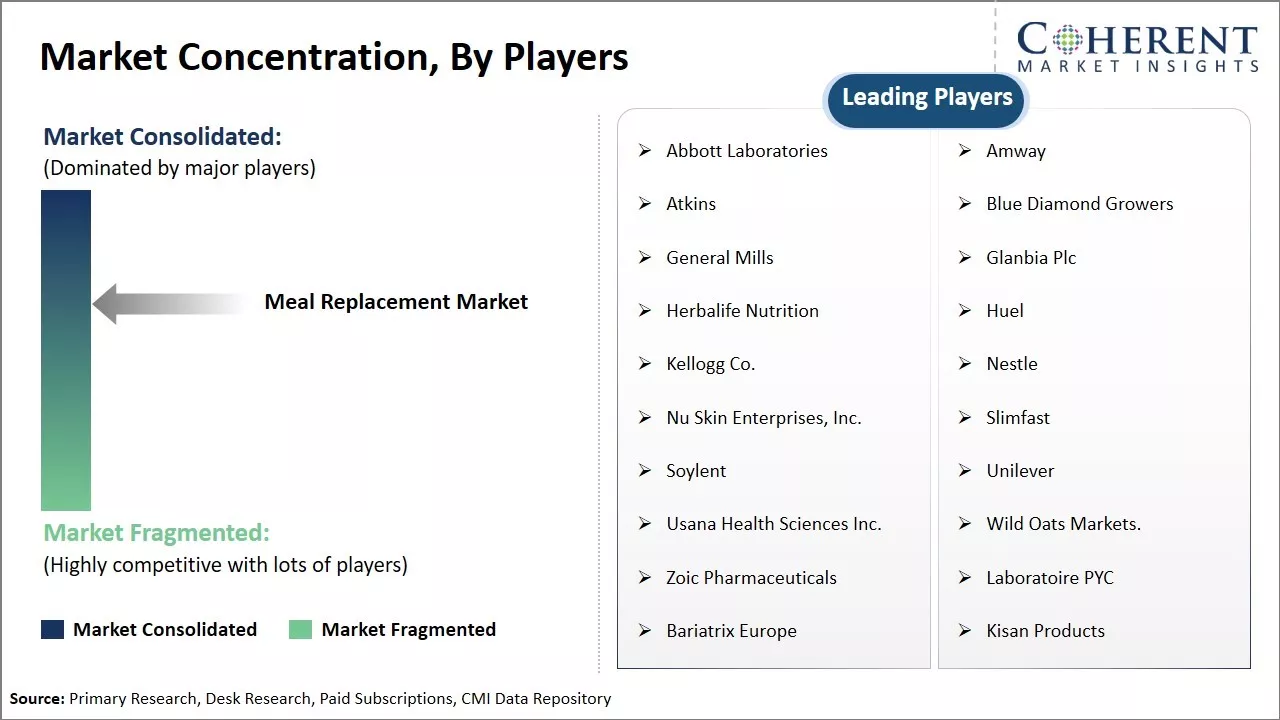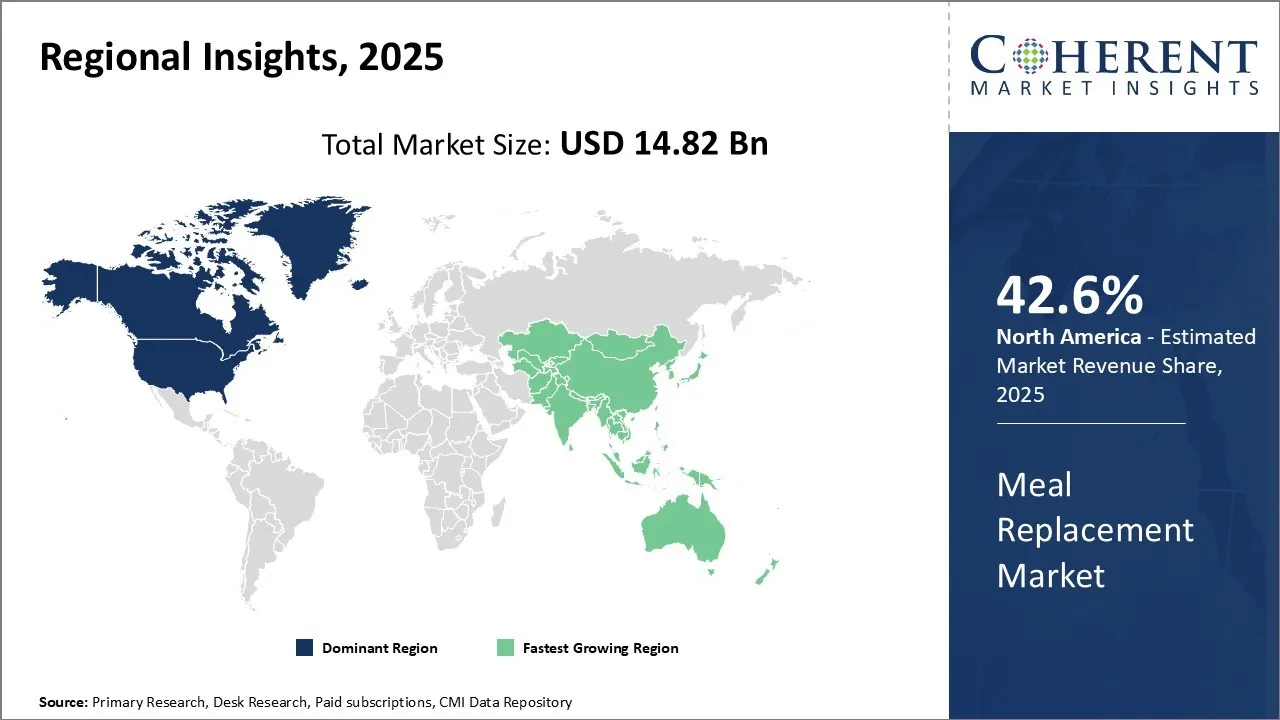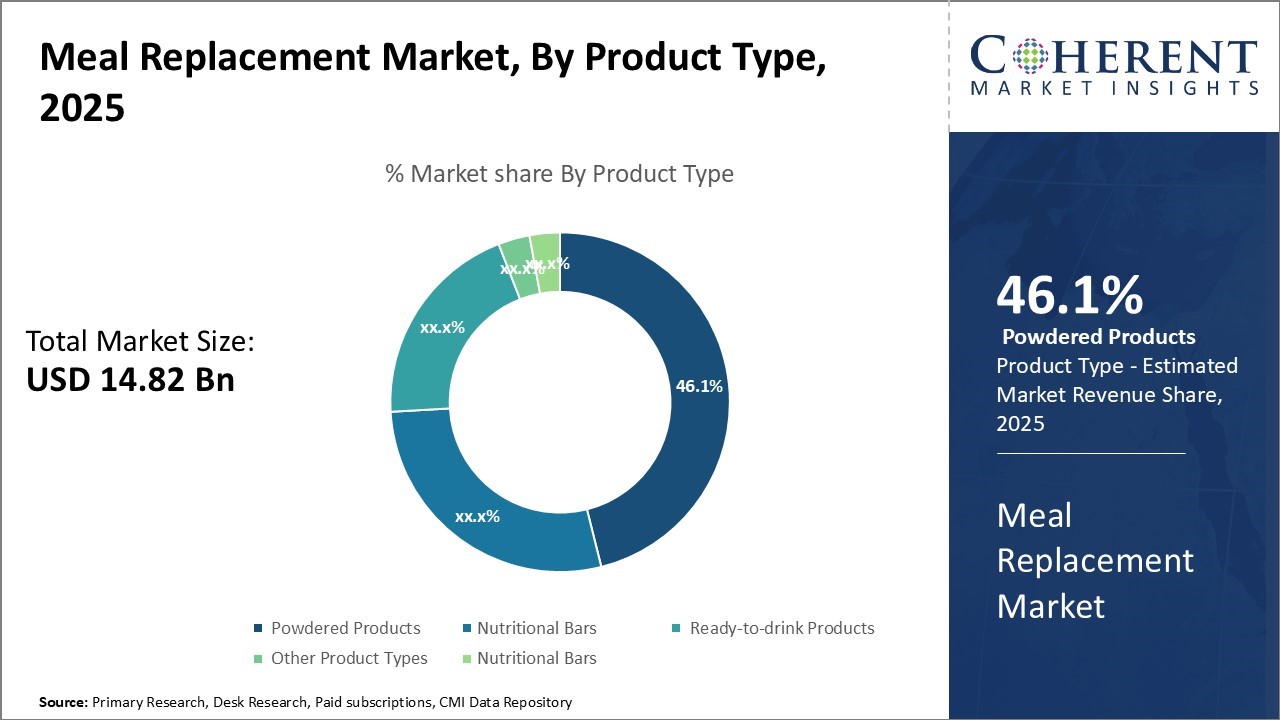Meal Replacement Market Size and Trends
The meal replacement market is estimated to be valued at USD 14.82 Bn in 2025 and is expected to reach USD 22.01 Bn by 2032, exhibiting a compound annual growth rate (CAGR) of 5.8% from 2025 to 2032.

To learn more about this report, Download Free Sample
Key Takeaways
- Based on Product Type, Powdered Product segment is projected to account for 46.1% of the global market in 2025, owing to its convenience and versatility.
- Based on Distribution Channel, the Hypermarket/Supermarkets segment is expected to capture 41.7% share of the market in 2025, due to their ability to provide a one-stop shopping destination.
- Based on Region, North America is set to dominate the global market with a 42.6% share in 2025.
Market Overview
The meal replacement market is witnessing significant growth due to increasing health consciousness among consumers and busy lifestyle. Consumer preference for healthy, convenient, and nutritious meal options is driving the demand for meal replacement products. Moreover, the ease of preparation and portability of meal replacement foods is further fueling the market growth.
Various product launches with innovative flavors and formats and marketing campaigns by leading players to raise awareness about health benefits are also propelling the meal replacement market growth.
Current Events and their Impact on the Meal Replacement Market
|
Current Event |
Description and its Impact |
|
Rising Global Food Inflation and Supply Chain Disruptions |
|
|
Regulatory Changes in Nutritional Standards and Health Claims
|
|
Uncover macros and micros vetted on 75+ parameters: Get instant access to report
End User Feedback and Unmet Demand in the Meal Replacement Market
End User Feedback in the Meal Replacement Market
Consumers in the meal replacement market appreciate the convenience, nutritional balance, and time-saving benefits these products offer. Busy professionals, athletes, and individuals with dietary restrictions often turn to meal replacements to meet their nutritional needs without the time commitment of traditional meal preparation. Products that are easy to prepare, such as ready-to-drink shakes and powders, are particularly favored for their portability and quick consumption. Additionally, the inclusion of functional ingredients like prebiotics, adaptogens, and nootropics is gaining popularity among users seeking added health benefits beyond basic nutrition.
Unmet Needs in the Meal Replacement Market
Despite the growing popularity of meal replacements, several unmet needs persist. Taste and texture remain significant barriers; many users report that products can be overly sweet, chalky, or bland, leading to consumption fatigue and inconsistent use. Sustainability issues, such as excessive packaging waste, are increasingly important to environmentally conscious users, prompting a demand for more eco-friendly packaging solutions. Furthermore, there is a call for greater personalization in meal replacement offerings, with consumers seeking products tailored to their specific dietary needs, preferences, and health goals.
Plant Based Meal Replacement
A plant-based meal replacement is a convenient, nutrient-dense option designed to provide balanced nutrition using only plant-derived ingredients. Ideal for busy lifestyles, it offers a quick and wholesome alternative to traditional meals without compromising on health or flavor. These shakes or powders typically contain a blend of proteins from sources like peas, rice, or hemp, along with healthy fats, fiber, vitamins, and minerals from fruits, vegetables, and superfoods. Perfect for vegans, athletes, or anyone seeking cleaner fuel, plant-based meal replacements support energy, digestion, and overall wellness.
In June 2025, Sur Nutrition—a leading brand in plant-based performance products—unveiled its Organic Meal Replacement Shake. Expertly crafted by chefs, this shake is designed to fuel athletes, busy professionals, and health-conscious individuals with wholesome ingredients and authentic flavor.
Market Concentration and Competitive Landscape

To learn more about this report, Download Free Sample
Market Drivers
Health-Conscious Consumers
The growing health and wellness trend has been a major driver propelling the meal replacement market growth in recent years. With the increasing prevalence of obesity and lifestyle diseases, consumers are becoming more conscious about their health and nutritional intake. They want options that are convenient and ensure they are meeting their daily protein, vitamin, mineral and other nutrient requirements without compromising on taste.
Meal replacements with balanced macros have emerged as a popular choice as they allow consumers to easily manage their calorie and nutrient consumption. Consumers no longer want to spend a lot of time in the kitchen and are more inclined towards quick, easy to prepare foods that also add health value. Meal replacements address this need perfectly as they are ready-to-eat or only require minimal preparation like adding milk or water.
The inclusion of high quality proteins, fibers and other essential vitamins and minerals in meal replacements helps consumers feel full for longer and maintain satiety. This curbs unhealthy snacking and prevents overeating. It has been seen that regular consumption of meal replacements as part of a calorie-controlled diet results in effective and sustainable weight loss. The increased focus on wellness and demand for convenient nutritional solutions has prompted many consumers to incorporate meal replacements in their diet and lifestyle.
Changing Lifestyles
Rising number of dual income households and hectic schedules have left consumers with little time for proper home cooked meals. People are constantly on the go and prefer portable food and beverage options that do not compromise on taste or nutrition. Meal replacements have emerged as a great solution for time-starved consumers to get balanced nutrition on the fly.
The easy, ready-to-consume formats of meal replacements like bars, shakes and snacks allow harried individuals to quickly refuel without much preparation effort. Busy professionals, students and millennial population have increased their uptake of these replacements as they fit perfectly well into their fast-paced routines.
Changing work styles like remote working and flexible timings have further boosted the appeal of meal replacements. People may not have access to healthy dining options or time for cooked meals through the day.
Meal replacements address this challenge with their compact, fully-packed formats. The variety available allows consumers to choose the types suitable for different times of the day- from hearty breakfasts and filling lunches to pre-and-post workout snacks.
Meal Replacement Market Insights, By Product Type: A Staple for On-The-Go Consumers
In terms of product type, powdered products contribute the 46.1% share of the market owing to their convenience and versatility. Powdered meal replacements offer users an easy way to consume nutritious meals anywhere, without refrigeration or special facilities for preparation. The ability to simply mix powdered products with water makes them ideal for busy lifestyles where prepping meals is difficult.
Powdered meal replacements also give users flexibility in terms of portion control and customizing ingredients based on dietary needs and preferences. The micronutrients and macronutrients contained in powdered form can be easily adjusted. This helps address the specific nutrition requirements of different demographic segments like fitness enthusiasts, diet conscious individuals, and the elderly.
Furthermore, powdered products have a longer shelf life than other types, reducing food wastage. Overall, the ease of use and adaptability of powdered meal replacements have made them the top choice for people seeking quick, healthy meals on the go. Growing strategic initiatives by the key players is expected to drive the segment growth.
For instance, in January 2024, Abbott announced the launch of its new PROTALITY™ brand. The high-protein nutrition shake is the first product in this line to support the growing number of adults interested in pursuing weight loss while maintaining muscle mass and good nutrition.
Meal Replacement Market Insights, By Distribution Channel: Hypermarkets dominate as it provide a One-Stop Shopping Destination
Hypermarkets/supermarkets contribute the 41.7% share to the meal replacement market distribution channel due their ability to offer a one-stop shopping destination. These large retail outlets stock a wide variety of grocery and household items under one roof.
For busy consumers, hypermarkets/supermarkets eliminate the need to visit multiple stores, saving valuable time. They also provide enhanced visibility and easy accessibility to meal replacement options amidst their diverse product lines. The massive shelf space allows supermarkets to stock popular meal replacement brands and flavors. Aggressive promotional activities, combo discounts and loyalty programs further encourage buyers.
Many locations also offer nutritious prepared foods, so customers can quickly purchase both groceries as well as ready meals during their visits. The long business hours of hypermarkets/supermarkets also fit into most people's schedules. Their strategic community locations combined with convenient parking facilities and accessibility via public transport have created a habit of grocery shopping among local residents.
In July 2025, LuLu Retail, a prominent hypermarket chain in the Middle East, expanded its presence in Saudi Arabia by launching a new store in the lively Al-Baghdadiyah Al-Gharbiyah area of Jeddah, situated along Al Andalus Road.
Regional Insights

To learn more about this report, Download Free Sample
North America Meal Replacement Market Analysis & Trends
North America has remained the dominant region in the global meal replacement market over the past decade with 42.6%. The large size of the population in countries like the United States and Canada along with high disposable incomes have made the region highly lucrative for meal replacement brands.
There is also a growing health and wellness trend among consumers in North America who want options to follow healthy diets easily without much effort. This has further supported the demand for meal replacement products like protein bars, shakes and snacks. Another key factor for North America's dominance is the strong presence of global leaders in the industry.
For instance, in June 2025, Sur Nutrition launched its certified-organic and plant-based meal replacement shakes. These shakes include North American-sourced PURIS pea protein.
Asia Pacific Meal Replacement Market Analysis & Trends
The Asia Pacific region has emerged as the fastest growing market for meal replacements in recent times, primarily driven by countries like India, China, Japan and Australia. Rapid urbanization, busy lifestyles and increasing health awareness among younger consumers have boosted the popularity of meal replacement products in Asia Pacific.
For instance, Indian brands offer protein-rich meal replacement shakes and snacks flavored with spices preferred locally. The expanding middle-class in Asia Pacific presents an enormous customer base for meal replacements in the coming years. Similarly, free trade agreements are improving import and export opportunities within the region.
In September 2025, Primal Power Nutrition (PPN), a start-up by professional sports coaches announced in Hong Kong. They would introduce Protein Matrix 100% Whey and advanced power pre-workout. It acts as a meal replacement protein powder.
Meal Replacement Market Outlook Country-Wise
The U.S. Meal Replacement Market Trends
The U.S. meal replacement products market is expected to grow significantly owing to increasing health consciousness among consumers is driving the demand for convenient and nutritious meal options. The busy lifestyles of many Americans also contribute to the popularity of meal replacement products, as they offer a quick and easy solution for maintaining a balanced diet.
Moreover, advancements in food technology have led to the development of more appealing and diverse meal replacement options, catering to a wide range of dietary preferences and needs. The growing trend of fitness and wellness, coupled with the influence of social media and health influencers, further boosts the market’s expansion. These factors collectively create a favorable environment for the robust growth of the U.S. meal replacement products market.
For instance, in September 2024, Sperri has invested in a Canadian plant-based meal replacement beverages makers to help fund its US expansion.
India Meal Replacement Market Trends
India meal replacements market is driven by rising health consciousness, rapid urbanization, higher disposable incomes, and a growing preference for convenient, nutritious meal alternatives, supported by innovations in functional foods, government initiatives promoting wellness, and the expanding availability of protein shakes, nutritional bars, and fortified ready-to-drink beverages.
For instance, in May 2025, Zantus Lifesciences LLP, an Indian nutraceutical start-up, co-founded by Abbott Nutrition. The company announced the launch of its low-carb meal replacement powders designed for pre-diabetics.
Market Report Scope
Meal Replacement Market Report Coverage
| Report Coverage | Details | ||
|---|---|---|---|
| Base Year: | 2024 | Market Size in 2025: | USD 14.82 Bn |
| Historical Data for: | 2020 To 2024 | Forecast Period: | 2025 To 2032 |
| Forecast Period 2025 to 2032 CAGR: | 5.8% | 2032 Value Projection: | USD 22.01 Bn |
| Geographies covered: |
|
||
| Segments covered: |
|
||
| Companies covered: |
Abbott Laboratories, Amway, Atkins, Blue Diamond Growers, General Mills, Glanbia Plc, Herbalife Nutrition, Huel, Kellogg Co., Nestle, Nu Skin Enterprises, Inc., Slimfast, Soylent, Unilever, Usana Health Sciences Inc., Wild Oats Markets., Zoic Pharmaceuticals, Laboratoire PYC, Bariatrix Europe, and Kisan Products |
||
| Growth Drivers: |
|
||
| Restraints & Challenges: |
|
||
Uncover macros and micros vetted on 75+ parameters: Get instant access to report
Analyst Opinion (Expert Opinion)
- The meal replacement market is poised for steady growth driven by increasing health consciousness among consumes. More people are opting for meal replacement as a convenient low-calorie solution for weight management or as a supplement for a busy lifestyle. The market sees opportunity in this consumer trend towards portable and easy to consumer food options.
- North America currently dominates the market dye to early adoption of healthy eating habit. However, Asia Pacific is expected to emerge as the fastest growing region supported by rising disposable incomes and exposure to Western Trends.
- Perception of meal replacement not being as satisfying as regular meals. Extensive R&D is being undertaken to enhance taste, texture, and variety to make meal replacement more enjoyable. Stringent regulations on product labelling and nutrients content also impact margin for companies. Localized product catering to regional tastes can help expand in new market.
Key Developments
- In February 2025, Urban Remedy, known for its organic ready-to-eat meals and juices, launched organic high-protein collagen meal replacement shakes. Responding to rising demand for clean protein and collagen, the product features a first-to-market organic bovine collagen sourced from sustainably raised, grass-fed cowhides.
- In September 2024, Arla announced the launch of meal-replacement milk-based drinks range in Denmark. The new range will be rolled out in the Netherlands and England following its domestic launch.
- In January 2024, Abbott introduced its new PROTALITY brand, a high-protein shake designed to aid adults in weight loss while preserving muscle mass and ensuring optimal nutrition.
Market Segmentation
- Product Type Insights (Revenue, USD Bn, 2020 - 2032)
- Nutritional Bars
- Powdered Products
- Ready-to-drink Products
- Other Product Types
- Distribution Channel Insights (Revenue, USD Bn, 2020 - 2032)
- Convenience Stores
- Hypermarkets/Supermarkets
- Specialty Stores
- Online Retailers
- Other Distribution Channels
- Regional Insights (Revenue, USD Bn, 2020 - 2032)
- North America
- U.S.
- Canada
- Latin America
- Brazil
- Argentina
- Mexico
- Rest of Latin America
- Europe
- Germany
- U.K.
- Spain
- France
- Italy
- Russia
- Rest of Europe
- Asia Pacific
- China
- India
- Japan
- Australia
- South Korea
- ASEAN
- Rest of Asia Pacific
- Middle East & Africa
- GCC Countries
- Israel
- Rest of Middle East & Africa
- Key Players Insights
- Abbott Laboratories
- Amway
- Atkins
- Blue Diamond Growers
- General Mills
- Glanbia Plc
- Herbalife Nutrition
- Huel
- Kellogg Co.
- Nestle
- Nu Skin Enterprises, Inc.
- Slimfast
- Soylent
- Unilever
- Usana Health Sciences Inc.
- Wild Oats Markets.
- Zoic Pharmaceuticals
- Laboratoire PYC
- Bariatrix Europe
- Kisan Products
Sources
Primary Research Interviews
- Senior executives and product managers from meal replacement companies
- Nutritionists and dietitians specializing in meal replacement products
- E-commerce platform managers and online retailers
- Health and wellness consultants
- Others
Databases
- Euromonitor International
- Others
Magazines
- Nutraceuticals World
- Food Business Magazine
- Natural Products Insider
- Nutrition Business Journal
- Others
Journals
- Journal of Nutrition and Food Sciences
- International Journal of Food Sciences and Nutrition
- Food and Nutrition Research
- Others
Newspapers
- The Wall Street Journal
- Financial Times
- Forbes
- Reuters Business News
- Others
Associations
- Council for Responsible Nutrition (CRN)
- Natural Products Association (NPA)
- International Food Information Council (IFIC)
- Academy of Nutrition and Dietetics
- Others
Public Domain Sources
- U.S. Food and Drug Administration (FDA) databases
- European Food Safety Authority (EFSA) reports
- World Health Organization (WHO) publications
- USDA National Nutrient Database
- Others
Proprietary Elements
- CMI Data Analytics Tool
- Proprietary CMI Existing Repository of information for last 8 years
Share
Share
About Author
Sakshi Suryawanshi is a Research Consultant with 6 years of extensive experience in market research and consulting. She is proficient in market estimation, competitive analysis, and patent analysis. Sakshi excels in identifying market trends and evaluating competitive landscapes to provide actionable insights that drive strategic decision-making. Her expertise helps businesses navigate complex market dynamics and achieve their objectives effectively.
Missing comfort of reading report in your local language? Find your preferred language :
Transform your Strategy with Exclusive Trending Reports :
Frequently Asked Questions
EXISTING CLIENTELE
Joining thousands of companies around the world committed to making the Excellent Business Solutions.
View All Our Clients

